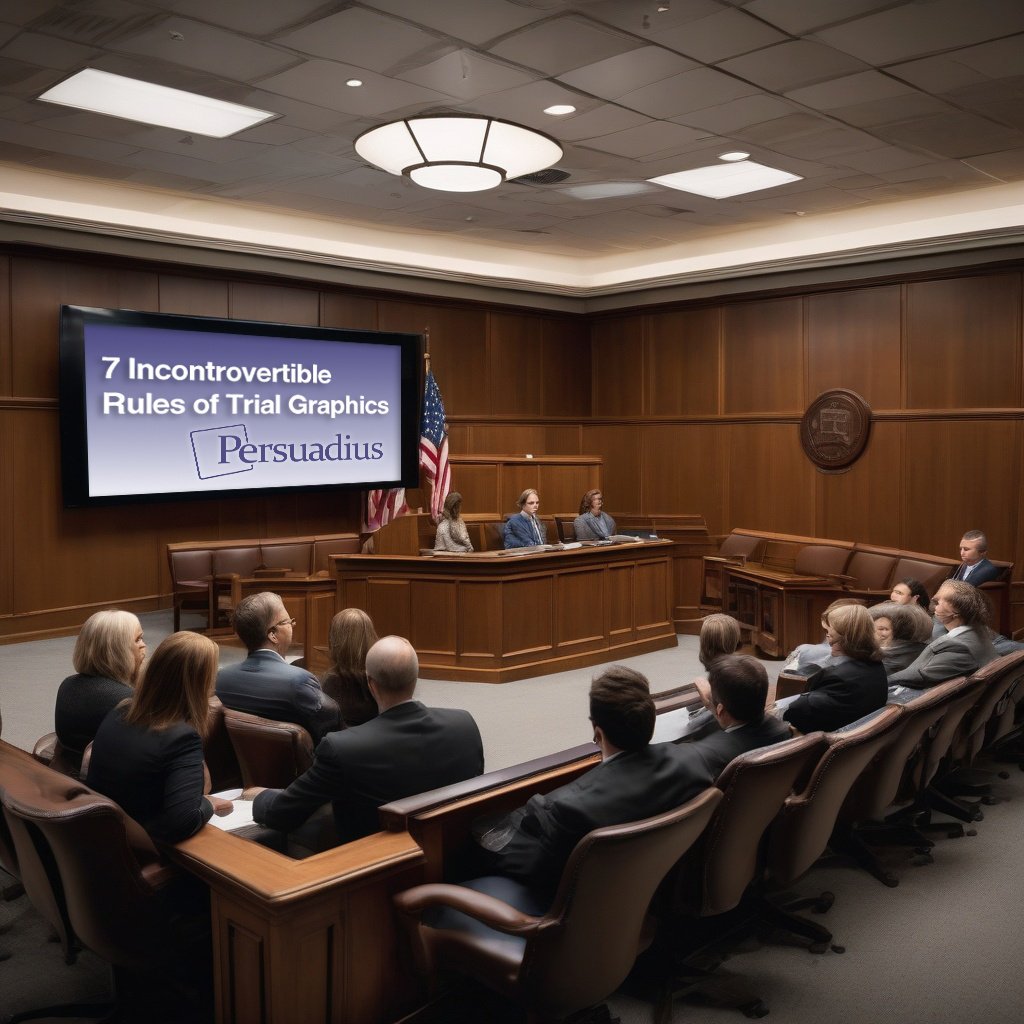Trial graphics are a crucial component of presenting a compelling case in court. From timelines to charts to animations, visual aids can help simplify complex information and make a strong impression on a judge and jury. To ensure your trial graphics are compelling and enhance your legal argument, here are seven hard-and-fast rules to follow:
1. Keep it Clear and Concise:
One of the most important rules for trial graphics is to keep them clear and concise. Avoid cluttering your visuals with too much information, and highlight key points supporting your case. Use simple language and visuals that are easy to understand at a glance. Follow my 20/20 rule. Use a maximum of 20 words on any slide, hopefully fewer, and be sure that the entire slide can be understood in less than 20 seconds. Again, hopefully, fewer. Never use a type size below 28 points. See 12 Ways to SUCCESSFULLY Combine Oral and Visual Presentations.
2. Use Visual Storytelling Techniques
Visual storytelling techniques are powerful tools for conveying complex information in a compelling and easy-to-understand manner. Using images, graphics, and multimedia elements, visual storytelling can captivate an audience and make a lasting impact. Especially in trial graphics, visual storytelling techniques can enhance engagement, evoke emotions, and effectively communicate a message. Storytellers can create narratives that resonate with their audience and leave a memorable impression through strategic use of visual elements such as color, typography, and composition. See Crafting Compelling Legal Arguments Using Storytelling Techniques — Paint a Picture for Your Jury.
3. Do NOT Stick to a Consistent Design:
Contrary to what an artist without a background in persuasion science will tell you, consistency is NOT crucial in trial graphics. It's not a beauty contest—it's a persuasion contest. And the best way to persuade is by keeping your audience engaged and curious. Please do not use the same template on every slide. Switch up your colors, move the title bar around, and change fonts and styles. All of this will keep your audience guessing and more engaged. See Could Surprise Be One of Your Best Visual Persuasion Tools?
4. Highlight Key Evidence:
Your trial graphics should highlight key evidence and support your legal arguments. Use visuals to emphasize important facts, timelines, and witness testimony that strengthen your case. Be strategic in presenting this information to make a compelling argument to the jury. See Planning For Courtroom Persuasion? Use a Two-Track Trial Strategy.
5. Keep it Relevant:
When creating trial graphics, keeping them relevant to the case at hand is essential. Avoid including unnecessary or extraneous information that could confuse the jury or detract from your main points. Stick to visuals that directly support your legal arguments and help tell your client's story. Generally, I like to over-create slides and then trim the presentation down. See How Many PowerPoint Slides Should You Use in a Typical Trial?
6. Practice and Prepare:
Before presenting your trial graphics in court, it's essential to practice and prepare thoroughly. Please familiarize yourself with each visual aid and how it supports your argument. Anticipate questions or challenges from the opposing counsel and be ready to defend your graphics confidently. Everyone who has followed my 30 to 1 presentation practice regimen has been successful at trial. See The Magic of a 30:1 Presentation Preparation Ratio.
7. Work with Professionals & Seek Feedback:
Of course, I would like you to work with Persuadius, but I understand you may have existing relationships. Please engage a high-end firm that understands these rules and is not just a PowerPoint shop. Don't be afraid to seek feedback from colleagues, mentors, or even focus groups on your trial graphics. Getting an outside perspective can help you identify areas for improvement and ensure your visuals are clear, persuasive, and compelling in court. See 7 Questions You Must Ask Your Mock Jury About Litigation Graphics.
Following these seven rules for effective trial graphics, you can create compelling visuals that enhance your legal argument and make a strong impression on judge and jury. Remember to keep your visuals clear, concise, and relevant, and practice confidently presenting them. With the suitable trial graphics, you can strengthen your case and increase your chances of success in court.
Other Persuadius articles and webinars devoted to persuading with trial graphics/litigation graphics:
- Free Persuadius Webinar: 5 Ways to Maximize Persuasion During Opening Statements — Watch Anytime
- Litigation Graphics: A Game-Changer in the Courtroom
- The 12 Worst PowerPoint Mistakes Litigators Make
- Lawyer Delivers Excellent PowerPoint Presentation
- 7 Ways to Avoid Making Your PowerPoint Slides Your Handout
- 12 Ways to Eliminate "But I Need Everything On That PowerPoint Slide"
- 16 PowerPoint Litigation Graphics You Won't Believe Are PowerPoint
- The Redundancy Effect, PowerPoint and Legal Graphics
- The Effective Use of PowerPoint Presentation During Opening Statement
- Don't Use PowerPoint as a Crutch in Trial or Anywhere
- How Much Text on a PowerPoint Slide is Too Much?
- Do Professionally Designed PowerPoint Slides Get Better Results?
- Why Reading Your Litigation PowerPoint Slides Hurts Jurors






Leave a Comment